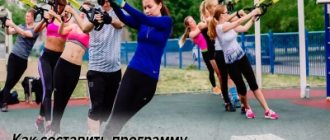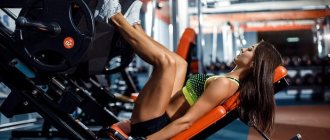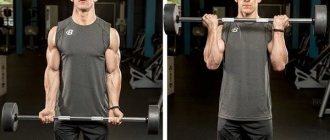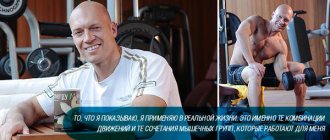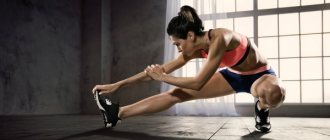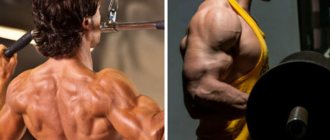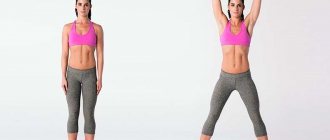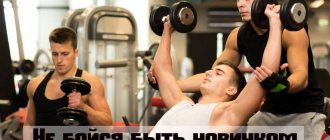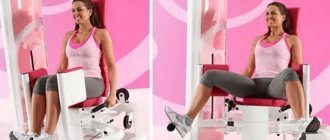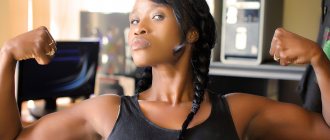Do you want to have harmoniously muscular legs? If you are serious about working on this part of the body, you need to pay more attention to the hamstrings.
A lot is known about the arm biceps, but few know how to pump up the hamstring biceps, and only a few can name truly working exercises for the hamstring biceps for the gym. Our expert, international master of sports, Alexey Hernandez Ortega, will tell you all the details of working out this biceps muscle.
Now that you are serious about getting a perfect body, you need to understand the importance of leg training. Imagine a guy showing off his broad shoulders on the beach with his stick legs peeking out of his shorts. It's an unsightly picture, isn't it?
To make your leg muscles grow, you need to put in a lot of effort. Usually, when planning a leg workout, guys start by working on the quadriceps. After a lot of intense exercises on the quadriceps, they move on to the thighs already tired. With the last of their strength, having done 1-2 sets of hamstring exercises, they consider that the task is completed. You know what? With this approach, you will never build powerful thighs! If you are serious about working on your body and want to achieve harmoniously developed leg muscles, pay more attention to your hamstrings!
In this article, you will learn everything about hamstrings: muscle anatomy, recommended training schedule, best exercises, and get a workout from a pro!
Anatomy
- Semitendinosus. This is a long and thin muscle of the back of the thigh. It is located closer to the inner leg area. It is responsible for the function of hip extension and is involved in the flexion and rotation of the lower leg.
- Semimembranosus muscle. It is also a long and thin muscle located even closer to the inner region of the leg. Responsible for hip extension and shin flexion. When the leg is bent, turns its lower half inward.
- Biceps. Consists of 2 heads. One of them is short, the other is long. This posterior thigh muscle group is the largest, occupying most of the surface. The biceps is responsible for straightening the lower extremities, bending the lower leg and turning it outward.
For people who do not know the anatomy of the human body well, it is recommended to look on the Internet where these muscles are located and their structure. This will help you better understand why you need to pump up your hamstrings.
The hamstrings are antagonistic muscles to the quadriceps, whose main function is static.
Isolation exercises
Basic exercises are good, but you shouldn’t forget about isolating exercises. With their help you can pump up individual biceps bundles.
Lifting the barbell while standing with a reverse grip
This exercise has many benefits:
- The coveted high peak appears at the biceps;
- The volume of the forearms visually increases;
- Elbows have additional protection from injury;
- The wrists are strengthened;
- Relief appears on the hands.
- Lower your shoulders down and press your arms to your body;
- Bending should only occur at the elbows;
- The arms should extend only upon reaching the lowest point;
- Exhale forcefully and calmly bend the barbell.
Lifting the barbell on a Scott bench
This exercise was invented by Larry Scott. It is he who should be thanked for creating such a bench. This type of lifting of the barbell perfectly works the biceps.
- Sit comfortably at a bench and place your hands on the surface;
- Take the barbell. It will be better if your training partner serves it to you.
- Start bending your arms, calmly lifting the projectile to your chin;
- Gently lower your arms with the barbell to the original position.
- You don’t need to lower the bar too low - this way you’ll work your arms better;
- If you feel pain, change your grip;
- Always maintain tension in the tendons throughout the entire approach.
Concentrated dumbbell raises with supination
It is often found in the programs of both beginners and professional athletes.
Let's look at the correct technique for concentrated biceps curls. In this case, we will sit and lean on the thigh:
- Sit on a bench and spread your legs wide;
- Take a dumbbell in your hand and lower your body a little;
- Rest your elbow on your thigh, it is recommended to place your other hand on your other leg;
- Raise the dumbbell to your shoulder, stay in this position for a couple of moments and return to the original position.
Features of the training
Many people in the gym believe that the biceps of the leg do not need pumping. They pay more attention to the quadriceps, because this muscle is larger and stronger, and therefore more visible. The result will be the same as if a person pumped up his biceps on his arms, neglecting his triceps.
If you don’t do exercises on the hamstrings, this can lead to the following:
- Disproportionality. This is especially visible if you look at the legs from behind or from the side.
- Inability to do a deep squat.
- There is a high risk of stretching the knee ligament or damaging the knees themselves, injuring the back of the thigh where the biceps muscle is located.
In addition, training the hamstrings allows you to achieve the following:
- Increased strength. Training the hamstrings and buttocks makes the triceps of the legs stronger. Therefore, weightlifters work them out without fail.
- Health. Many muscles have a pair (antagonist). In the biceps of the leg it is the quadriceps. If you pump only the last muscle, then a distortion occurs. This negatively affects the bones and ligaments of the legs. As a result, it can provoke pathologies in the hip joint and knees.
Therefore, you need to pump all the muscles. It is important to understand that they are not divided into primary and secondary. Only with comprehensive training will you be able to build muscle mass and get a beautiful, athletic body. And this applies to both boys and girls.
Mistakes when training legs
This is actually a fairly common problem, since most leg exercises work the quadriceps and glutes well, while the rear biceps lag behind. As a rule, the problem is that when training your legs, you, first of all, pump up the thigh muscles as a whole, using, again, the quadriceps muscle as much as possible, and perform accentuated biceps curls after, when you are already quite tired. Therefore, in order to achieve a noticeable effect, you need to slightly repurpose the load on your legs: in order for development to proceed evenly, alternate, starting with the quadriceps and buttocks, then with the biceps.
So where is this proverbial muscle located? A is located on the back of the thigh, essentially connecting the pelvis and lower leg. Hence its main function is to flex the lower leg when the thigh is stationary and extend the thigh if it is mobile, which, by the way, also involves the buttocks.
Any girl should pay attention to training this particular muscle, as often the posterior biceps is very poorly developed, and this greatly spoils the aesthetic component of your legs.
Therefore, let’s not dwell on it for too long, but hurry to the gym to figure out the most effective exercises that train our hamstrings the way they should.
Recommendations for training
Exercises for the back of the thigh are performed in compliance with certain rules:
- First priority. Exercises for the biceps femoris muscle are recommended to be done at the beginning of training. She is very resilient, so she has enough strength to perform other movements.
- Quantity. The best exercises for the back of the thigh should be performed with a significant weight of 6-8 rubles.
- A complex approach. The exercises will be effective if you simultaneously work out other leg structures (triceps, quadriceps, buttocks).
- Alternating loads. During training, it is recommended to perform isolation and heavy compound movements. This will help you touch the deep layers of muscle fibers and accelerate their hypertrophy.
You can pump up the back of your thighs if you exercise intensively just once a week. The most important thing is to know what exercises to do.
The biceps femoris muscle provides the ability to bend the leg at the knee joint, rotate it outward, and extend it at the hip joint.
When to train hamstrings
You can swing your hips in one of three ways. One week of leg training, start with the hamstrings, the next week, start with the quadriceps. You can also divide the program: biceps and quadriceps in the morning, other muscle groups in the evening. Or set aside a separate day for the back of the thigh. If you are looking to significantly increase your hamstrings, the latter option will be preferable. It's difficult to dedicate a day to just one muscle group, so you'll likely have to work on your legs as a whole. In this case, choose the first or second option.
Warm-up and stretching
And the last thing you should know before pumping up your hamstrings is warming up and stretching the muscles. Start with 10-15 minutes of walking on a treadmill or cycling. Then stretch and relax. Stretch not only your legs, but your entire body, including your core. Stretching will help you avoid injury and work harder. Stretch your muscles between sets and at the end of your workout.
The best exercises in the gym
Of course, you can train your legs at home. However, exercises will be more effective in the gym. There you can work out your legs on simulators and not only your hamstrings, but also other muscles, such as your calves, and if necessary, consult a professional trainer. After all, no matter what movement is made, the correctness of its execution is very important. Here are examples of the best exercises for the hamstrings in the gym.
Raising the body while standing on your knees
This exercise is also called hyperextension. To perform this you will need a special simulator or partner. Step by step steps:
- Place your ankles under the pads on the machine and rest your knees on the cushion. If there is no special equipment, then you can kneel on a soft carpet and ask your partner to hold your feet.
- As you exhale, bend forward, moving your pelvis back. As a result, the body should be parallel to the floor. Squeeze your hamstrings and straighten up.
At first glance it may seem that this is an easy exercise, but it is not. For a better understanding of how to perform it correctly, it is recommended to watch a video of it.
Most hamstring exercises also work the gluteal muscles and partially the quadriceps.
Leg bending in the simulator
Starting position for hamstring curls on a special machine:
- Install the support pillow in such a way that your knees can be slightly bent and your heels can easily touch your buttocks. During the exercise, it should be on the Achilles, not rolling.
- You should not put too much weight, as this exercise is not for the back, but for the legs.
- After the simulator is set up, you need to lie face down on its bench, resting your limbs on a pillow.
How to do the exercise:
- Bend your legs at the knee joints so that the heels begin to move towards the buttocks, the limbs bend more and more.
- Continue the movement as long as the hip stretch allows. Ideally, your heels should touch your buttocks.
- At the peak of the range of motion, tense the biceps of the thigh, then straighten and lower your legs.
The optimal number of approaches is 6-8 times. However, if necessary, it can be increased to 10-20.
Before you start working the legs and back of the thigh, the muscles need to be warmed up. 10-15 minutes of running or walking on an incline will prepare you for your workout and eliminate the risk of sprains.
Deadlift
Step by step steps:
- Place the barbell in front of you on a special stand at the level of the knee joints.
- Take it with a straight closed grip and remove it from the stand.
- Take a step back, straighten up, move your shoulders back a little.
- The feet should be at a distance of 15-20 cm.
- While inhaling deeply, lower the barbell to knee level or slightly lower.
- As you exhale, rise with your shoulders back.
During training, the spine should always be straight. When lowering the barbell, you need to bend your knees slightly so as not to injure yourself.
Deadlift or Romanian deadlift is one of the basic exercises with a barbell, which, among other things, has a good effect on the hamstrings, effectively working and stretching it.
Single leg deadlift
Technique:
- Take dumbbells in your hands. Stand straight, look forward, back straight.
- Move your left leg back a little. This position is called a stand-up position.
- Hands with dumbbells are lowered down. As a result, the weights should be at hip level.
- As you exhale, bend your supporting leg slightly and move the other leg back even more. The body leans forward until it is parallel to the floor. Stay in this position for 1-2 seconds.
- As you exhale, return to the starting position.
- Repeat with the other leg. Do 6-8 approaches with each limb.
This exercise for the hamstrings can also be performed at home if you have dumbbells or weights.
Bend forward with a barbell on your shoulders
Preparation:
- Set the slats to the required height (they should not touch when tilted).
- Place the bar slightly below shoulder level.
- Climb under it. Connect the shoulder blades. Place the bar in the middle of the trapezius muscles.
- Remove the barbell and step back a couple of steps.
- Place your feet at hip level. If you have poor stretching, you can bend your knees slightly.
- The body is straight, the lower back is slightly arched.
How to do the exercise:
- As you inhale, lean forward, pushing your chest out a little. Lower yourself until your torso is parallel to the floor. While driving, look straight ahead.
- Stay in the bend for 2-3 seconds.
- By tensing your buttocks and hamstrings, rise to the starting position. After this, exhale.
Do not keep your back round while performing the exercise. The movement is done smoothly, without jerking.
A quality hamstring workout involves technically challenging exercises that are potentially dangerous for beginners.
Squat
Technique:
- Feet shoulder-width apart or slightly wider. Knees slightly bent.
- You can hold your hands in front of you, clasp your hands, or hold on to a support.
- Pull in your stomach and butt, and place your weight on your heels.
- Do a squat while inhaling. At the same time, monitor the position of your knees. They should be directed towards the toes and not go beyond them.
- As you exhale, rise up and stretch your knees.
In conclusion, I would like to add that if your hamstrings hurt after intense exercise, that’s good. This means the muscles are pumping. However, if the pain is very severe and does not go away for a long time, you should contact a medical facility for diagnosis. There may have been an injury. To avoid injury, it is very important to follow the exercise technique. At first, it is recommended to train under the supervision of a trainer.
Hyperesthesia: it should not be discounted
And for some reason this exercise is mostly preferred by girls. It uses many muscles, including the hamstrings. It is performed in a special machine called a Roman chair or a back extension machine. The athlete's legs are secured with the hips resting on a special support. Further:
- The body hangs down when tilted upside down. The back in the starting position is located in line with the legs.
- Then you need to tilt your body forward, the angle of inclination is approximately 60 degrees, your back is slightly rounded.
- In the lower zone of the exercise, you need to cross your arms over your chest and smoothly return your torso to its original position, fixing your body for a second. The planned number of approaches and repetitions is done.
Hyperesthesia is also done to strengthen the muscles of the back, buttocks, and abs. With sufficient physical preparation, you can perform crunches - one of the types of exercises mentioned. The latter option also involves the oblique abdominal muscles.
Important! Exhalation is carried out on the rise.
Reference. The benefit of hyperesthesia is also that it strengthens the spine, maintains muscle tone, and is an excellent prevention of intervertebral hernia.
These useful curls are highly recommended not only for those who want to build up their hamstrings, but also for people who lead a sedentary lifestyle.
Base for working out the biceps muscle
The exercises indicated in this material are suitable for women and men, but there are certain nuances that affect the result.
Weighted squats (wide stance)
Rules for performing the exercise that must be strictly followed:
- Straight back, lumbar and abdominal muscles in a tense state;
- The movement begins from the pelvis, not the knees. Tilt the pelvis back according to the principle of sitting on a chair;
- The legs should bend approximately to a right angle;
- Keep your knee motionless; it should not go beyond the toe, otherwise injury cannot be avoided;
- When lifting the barbell, a strong pushing motion occurs. At the same time, the cervical spine and the buttock muscle are well felt. The legs rest their heels on the floor without transferring the center of gravity to the toes.
It is recommended to first practice this exercise without weights or using a body bar. Such a “rehearsal” will make it possible to determine the optimal width of the feet for the training person, as well as the angle of rotation of the toes when the DMB is worked out at the maximum level.
In addition, it should be taken into account that the deeper the squat, the more the gluteal muscle works. Therefore, deep squats are more suitable for girls. For men, it will be enough to squat to a level where the thighs are parallel to the floor.
Squats with dumbbells
Execution rules:
- Hands with projectiles are lowered and held in a straight position;
- The position of the feet is parallel to each other, slightly wider than the shoulders.
- The emphasis is on the heels (do not lean forward!).
